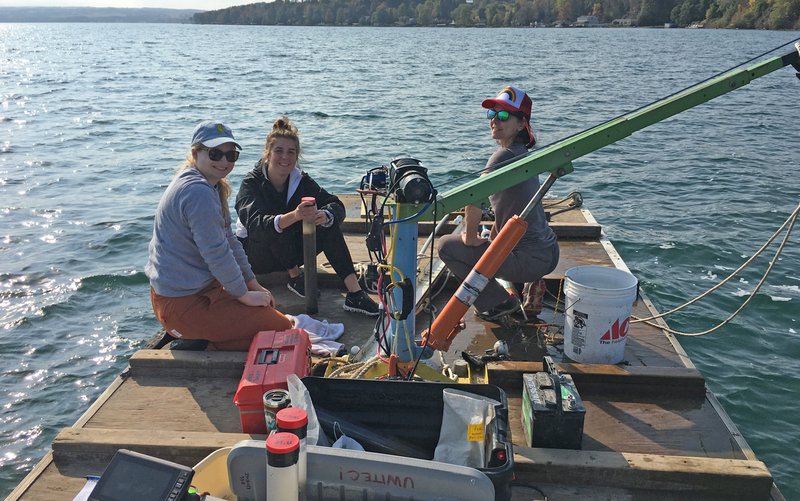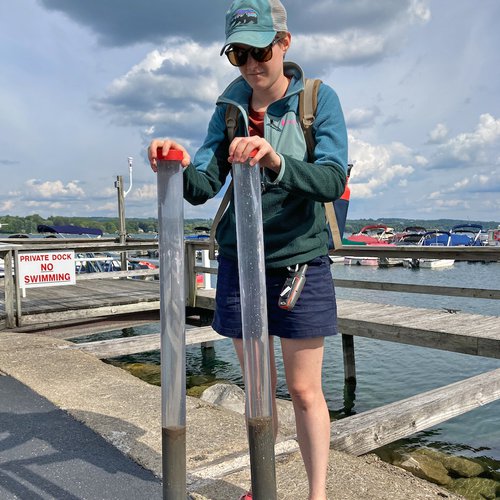
Researchers from the Departments of Earth & Environmental Sciences and Civil and Environmental Engineering collect sediment cores from Skaneateles Lake in October 2021.
by Renee Levy
Skaneateles Lake in Upstate New York is one of the cleanest, clearest freshwater lakes in the country, the source of drinking water for the City of Syracuse and a hub for recreation. Since 2017, however, harmful algal blooms (HABs) have been observed in the lake each summer, potentially threatening the area’s chief water supply.
HABs occur when colonies of cyanobacteria grow out of control. “They can be very toxic,” says Christopher Scholz, professor of earth and environmental sciences in the College of Arts and Sciences (A&S). “If there's a HAB in a freshwater lake, you certainly don't want to be drinking that water and you don't want to be bathing in it or have your dog swimming in it.”

Scholz’s research focuses on paleolimnology—reconstructing the past environments of inland waters through their geologic record—and he has studied climate change using sedimentary analysis of lake basins ranging from Lakes Malawi and Taganyika in the East African Rift Valley to Lake Baikal in Siberia, to freshwater lakes in Upstate New York. He’s now using similar techniques to study environmental changes in Skaneateles Lake and nearby Oneida Lake over the last 350 years, a starting point for research that may eventually provide a historical record of environmental conditions leading to HABs on the lakes.
Scholz has received $34,000 from the Water Resources Institute of New York State, a program based out of Cornell University, to collect sediment cores from the two lakes to determine spatial patterns of sedimentation and take measurements of nutrients including phosphorus, carbon and nitrogen to see how those have varied over time.

“The layers of sediment at the bottom of a lake basin are essentially a tape recorder of environmental change over time,” Scholz says. “Within this relatively small project, we're trying to get a sense of how the loading of nutrients into the lakes have changed just over the last 300-350 years, from precolonial times to the present.”
Skaneateles Lake is an oligotrophic lake, meaning it contains low nutrient content leading to clear water due to limited algae growth. Scholz says the recent HABs are unusual. “We know essentially nothing about past, ancient occurrences of HABs in the lake,” he says.
Oneida Lake, by contrast, is a eutrophic lake. “Parts of it turn green every summer on account of high biological productivity, and there’s longer history of HABs occurring,” he says.
Comparing sediment cores from the two lakes may provide answers to environmental conditions that lead to HABs.

Scholz is collaborating on the project with Syracuse University colleagues Charles T. Driscoll, University professor of environmental systems and distinguished professor of civil and environmental engineering in the College of Engineering and Computer Science, and Melissa Chipman, assistant professor of arctic paleoecology and paleoclimate in A&S’ Department of Earth and Environmental Sciences. In partnership with the New York State Department of Environmental Conservation, the Skaneateles Lake Association, and the Oneida Lake Association, the team is collecting core samples from both lakes to quantitatively measure how the sediment in each lake changed in accumulation and composition over time, as well as to establish patterns of sediment accumulation in different locations in the lakes.
“Sediment doesn't accumulate evenly all around the bottom of a lake,” Scholz says. “So, identifying the key sites to evaluate these kinds of changes is very important and will inform future studies.”
Ultimately, understanding past history of environmental change leading to HABs may help scientists protect water quality in the future. “We can’t take these remarkable natural resources for granted,” Scholz says. “We live in a changing world and water conditions are definitely evolving.”
